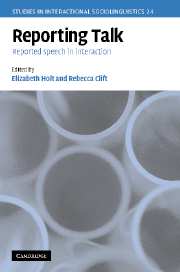Book contents
- Frontmatter
- Contents
- List of contributors
- Acknowledgements
- Transcription conventions
- 1 Introduction
- 2 Interactive Footing
- 3 ‘I'm eyeing your chop up mind’: reporting and enacting
- 4 Assessing and accounting
- 5 Getting there first: non-narrative reported speech in interaction
- 6 Reported thought in complaint stories
- 7 Designing contexts for reporting tactical talk
- 8 Active voicing in court
- 9 Speaking on behalf of the public in broadcast news interviews
- 10 The dead in the service of the living
- References
- Index
8 - Active voicing in court
Published online by Cambridge University Press: 22 September 2009
- Frontmatter
- Contents
- List of contributors
- Acknowledgements
- Transcription conventions
- 1 Introduction
- 2 Interactive Footing
- 3 ‘I'm eyeing your chop up mind’: reporting and enacting
- 4 Assessing and accounting
- 5 Getting there first: non-narrative reported speech in interaction
- 6 Reported thought in complaint stories
- 7 Designing contexts for reporting tactical talk
- 8 Active voicing in court
- 9 Speaking on behalf of the public in broadcast news interviews
- 10 The dead in the service of the living
- References
- Index
Summary
Introduction
This chapter, an exploratory study of the functions of DRS in legal testimonies, investigates the use of DRS in witnesses' answers to questions posed during direct and cross-examination. The analysis will focus on the evidential and moral function that DRS has in this context. The evidential function of this discursive device is emphasised by the fact that witnesses often locate it in the expanded parts of their answers, after having given a general description or evaluation of discursive events. The moral function of DRS emerges when witnesses use it to accomplish actions which they are forbidden by court procedure from accomplishing overtly, such as expressing opinions or evaluations of events or situations they recount. This analysis focuses in particular on lay witnesses. Because they testify not as experts giving an informed opinion about elements of the case, but as individuals who are required to demonstrate that they have experienced the facts they recount directly, lay witnesses in particular must find strategies for conveying anything that goes beyond simple description.
Witness examination and cross-examination
The data used in this study are taken from an Italian criminal trial, a murder case, that attained a good deal of notoriety, in part because the victim seemed to have been selected according to random criteria and in part due to suspicions that the two defendants, two university researchers in the field of law, had been motivated by misplaced professional curiosity to attempt a sort of macabre academic exercise in committing the perfect crime.
- Type
- Chapter
- Information
- Reporting TalkReported Speech in Interaction, pp. 195 - 220Publisher: Cambridge University PressPrint publication year: 2006
- 2
- Cited by



